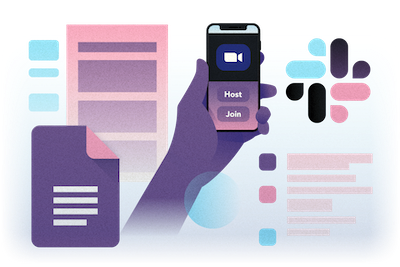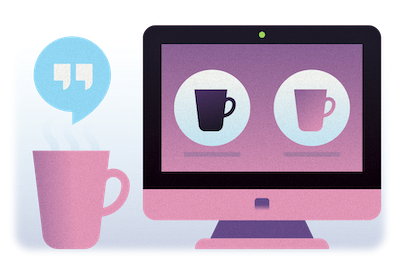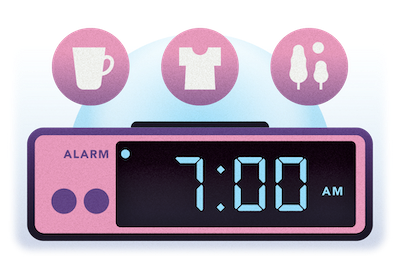
The way we work is changing. It’s changing much faster than expected in light of a global pandemic that necessitates work from home policies, but we’ve been heading in this direction for a while.

Even when I was in the office, I was guilty of sometimes pinging co-workers on Slack who sat next to me to ask quick questions or share a highly relevant meme. But for longer work- and non-work-related discussions, it was nice to be able to swivel to face my co-workers and hash things out verbally.
There are a lot of benefits to working in an office — otherwise, people wouldn’t do it. It’s easier to argue your point in a meeting when you can clearly see your colleagues’ body language and don’t have to worry about a frustrating glitch interrupting the momentum of the conversation. Offices are also free from many of the distractions that make working from home occasionally maddening.
There’s also an unquantifiable benefit to being around the same people day in and day out, all working towards a common goal. You see what people eat for lunch everyday and notice the pictures they choose to keep on their desks. Quick conversations by the coffee machine add up, and pretty soon you’ve built relationships that make the workday a lot more enjoyable.
Now that we’re living more isolated lives, we’re missing the creature comforts of regular human contact. This loss can negatively affect employees’ well-being, which ultimately impacts productivity and company culture.
We talked to four engineering managers about how their daily workflows and management strategies have changed in the wake of the Covid-19 pandemic. While they each had different approaches to enabling a smooth transition to work from home, everyone we talked to agreed maintaining lively channels of communication and preserving a sense of community is key when face-to-face interaction is no longer possible.
The Replay is a weekly newsletter for dev and engineering leaders.
Delivered once a week, it's your curated guide to the most important conversations around frontend dev, emerging AI tools, and the state of modern software.
 Robert Raymond, director of software development at HUB International. HUB International is an insurance brokerage providing wealth management, property, casualty, risk management, employee benefits, and life and health products and services across North America.
Robert Raymond, director of software development at HUB International. HUB International is an insurance brokerage providing wealth management, property, casualty, risk management, employee benefits, and life and health products and services across North America.
 Jonathan Taylor, solutions architect at a B2B media company covering news, best practices, and technology in the manufacturing space. Jonathan supports a development and support team that assists with infrastructure networking.
Jonathan Taylor, solutions architect at a B2B media company covering news, best practices, and technology in the manufacturing space. Jonathan supports a development and support team that assists with infrastructure networking.
 Joey George, VP of global software R&D at Stratasys (formerly GrabCAD). Stratasys manufactures 3D printers and 3D production systems for office-based rapid prototyping and direct digital manufacturing solutions. Joey has years of experience working with remote teams and contractors.
Joey George, VP of global software R&D at Stratasys (formerly GrabCAD). Stratasys manufactures 3D printers and 3D production systems for office-based rapid prototyping and direct digital manufacturing solutions. Joey has years of experience working with remote teams and contractors.
 Pascal Kriete, director of engineering at LogRocket. LogRocket is a frontend debugging and APM company based in Boston, MA. Pascal heads a team of engineers who specialize in developer tools, event processing, and building highly available distributed systems.
Pascal Kriete, director of engineering at LogRocket. LogRocket is a frontend debugging and APM company based in Boston, MA. Pascal heads a team of engineers who specialize in developer tools, event processing, and building highly available distributed systems.
Popular enterprise technologies like Google Docs and Skype have enabled us to work collaboratively irrespective of physical location for years. But now that we’ve got no other choice, some managers are running up against workflow snags and struggling to make the transition to an office-free work environment.
“Everything that’s difficult about management is easier in person,” says Pascal Kriete, director of engineering at LogRocket.
Management is all about building personal relationships. The better a manager’s rapport with their team members, the easier communication, accountability, innovation, and collaboration become. With everyone suddenly siloed in their homes, keeping a finger on the pulse of the entire team is a bit harder.
“You don’t have the opportunity to have the one-off interactions,” says Pascal. “They’re all moments where you can turn around or go to the conference room, or where you can talk to someone who is working on something completely different over lunch.”
Conversely, for Joey George, VP of global software R&D at Stratasys, the transition has been pretty easy. Joey is responsible for his company’s offices in Boston, Estonia, and the UK, so he’s used to working collaboratively across time zones.
“The nice thing about it is it forced us to figure out remote work in an intentional way,” he says.
For Joey, adapting to remote work and other changes starts with hiring. “You have to have people who are good communicators and who go out of their way to be collaborative,” he says. “You have to have a center of gravity in each site so that if you have a team that’s across two sites, they aren’t bottlenecks.”
Joey’s team has been using video calls as part of their day-to-day operations for seven years. “There are certain habits that you can get used to,” he says.
But it takes time to develop a level of ease and comfort with collaborative tools. Even if a solution is intuitive, some people may have trouble remembering simple etiquette unique to video conferencing with large groups or editing community documents. While Joey’s team is accustomed to the nuances of virtual communication, other teams may be adjusting to fully remote collaboration for the first time.
Overly chatty co-workers on Zoom may be endearing at first, but little distractions make a big difference when video conferencing is the only way to hold a meeting. Robert Raymond, director of software development at HUB International, has run up against some of these granular issues that needlessly impact productivity.
 “I’m trying to get everyone trained on simple stuff, like keeping your mic on mute unless you’re speaking,” says Robert. “That’s fine when you’re four or five people, but when you’re 20 or 30, it can be distracting. We’re trying to figure out what the best channel of communication is.”
“I’m trying to get everyone trained on simple stuff, like keeping your mic on mute unless you’re speaking,” says Robert. “That’s fine when you’re four or five people, but when you’re 20 or 30, it can be distracting. We’re trying to figure out what the best channel of communication is.”
Because employees can’t lean over their co-worker’s desk to ask quick clarifying questions, Jonathan Taylor, solutions architect for a B2B media company, says it’s especially important right now to have a single source of truth all team members can look to for quick answers to any of their questions.
“We really need to step up our documentation game,” Jonathan admits.
“Before this hit, we had been working towards more centralized Wiki and documentation tools,” he continues. “We have our own instance of GitLab that we host. We had all these sort of scattered tools that we had experimented with — source control and documentation tools and Wikis and all these aggregation points — but they’re all really dispersed and they weren’t maintained very well.”
Jonathan has noticed one unexpected benefit of this need to share and centralize information: “We’re doing a lot more asynchronous code sharing and information sharing, which I think is good,” he notes.
Overall, managers have faced small obstacles in this transition and seen that frequent communication is the quickest way over them. While ensuring your team has thorough documentation and jumping on video calls may seem like a bit of a time-suck at first, it pays off in the long run.
In many ways, the pandemic has only accelerated a need we already knew we’d have. It’s best practice to have all sources of truth, communication channels, and documentation available online in a world that increasingly operates through purely digital mediums.
Tech leaders right now are relying on the tools you’d expect — Google Docs, Microsoft Teams, Slack, Zoom. But the ways different teams use these tools vary and can make or break company morale and productivity.
At his B2B media company, Jonathan initially connected with team members through virtual one-on-ones that gave him a chance to get some face time with individuals to discuss their personal goals, concerns, and questions about the company.
“It was sort of an open floor for career development and whatever else that we wanted to talk about,” he says. “I initially suspended those and did more email and chat.”
After a while, Jonathan switched from conducting one-on-ones over email and began holding the sessions over video chat. For his team, this extra hour of video chat didn’t work out too well.
“There’s so much adjustment and so many video conferences that there was some video conference fatigue,” he noted. “I felt that those one-on-ones contributed to that fatigue.”
Axing one-on-ones reduced overall time spent on Zoom each week, which Jonathan believes can help reduce video conference fatigue and improve morale.
These kinds of sacrifices may not suit all managers, but in Jonathan’s case, this is a helpful and necessary schedule change under the current circumstances. Being mindful of signs of fatigue among team members is key to maintaining productivity and employee wellness.
 In place of constant video conferencing, Jonathan has seen an uptick in messaging and chatting between co-workers. His B2B company uses Microsoft Teams, which allows users to track metrics, including the volume of messages being sent between team members.
In place of constant video conferencing, Jonathan has seen an uptick in messaging and chatting between co-workers. His B2B company uses Microsoft Teams, which allows users to track metrics, including the volume of messages being sent between team members.
While video conferencing can become tedious and burdensome for some teams, others view it as an opportunity to preserve personal relationships when being in the office isn’t an option.
“We over-communicate with video instead of just audio so that we can build good relationships with people even when we’re not physically in the same office,” Joey explains.
For quick questions and check-ins, LogRocket mainly relies on Slack. As a communication channel, Slack invites informal, live messaging between team members and across departments.
“It’s primarily Slack, and then video calls for things that are worth having a call over,” says Pascal. “I wish there were more ways to communicate. For management, we do Slack stand-ups three times a week. It’s all about that extra touch point.”
In addition to the usual tools, HUB International uses Citrix, which provides secure apps and data on any device, network, or digital workspace to promote collaboration — including employees’ personal devices.
“We have a Citrix environment for our call center, and we actually ended up buying a few hundred Citrix ASA boxes to deploy at home,” Robert says. “People can plug in their phones and we don’t have to worry about being hijacked.”
Giving employees a little slack regarding how they communicate helped to keep people connected under these new circumstances.
An unavoidable pitfall of the switch to work from home is that company culture suffers; there’s really no way around it. You can’t genuinely replace the value of face-to-face interactions, work lunches, and company outings with a Zoom call.
“Before, if we were doing roadmap planning, we would go to a brewery and do the planning on a projector and then hang out for a few hours,” says Robert. “The fact that we’re not able to do that is a lot more detrimental than not being able to have meetings in a physical room.”
Still, Robert and other managers are finding small ways to make up for the lack of opportunities to bond with co-workers, especially in the absence of the ad hoc chit-chat that builds camaraderie among co-workers.
“I find there’s less just chatting or hanging around after meetings,” says Jonathan. “So spending those two minutes after a meeting to chat, I think that’s beneficial to us.”
When it comes to company culture, Joey goes back to one of the most reliable determinants of company success: people. Ultimately, he says, people dictate company culture. The right people will naturally foster a healthy and jovial work environment.
“We had people who had that culture when we came in, and we maintained it,” says Joey. “As we onboard new people, they know this is the way of working. You have to pick it up and then be intentional about it if you have a significant number of new people. You don’t get it by osmosis.”
“So we tell them some best practices,” he continues. “As soon as people experience it, they understand what works better and what doesn’t. They’ll say, ‘I tried video and it works better. I have a better connection with people and people are more willing to do it when they see the results.’”
 “In the UK office, there’s a recurring meeting that they were able to transfer to a virtual meeting, and that’s worked out fairly well. In other offices in Boston, we’ve added a happy hour every Friday night or Friday afternoon,” Joey adds.
“In the UK office, there’s a recurring meeting that they were able to transfer to a virtual meeting, and that’s worked out fairly well. In other offices in Boston, we’ve added a happy hour every Friday night or Friday afternoon,” Joey adds.
Joey also uses Google Hangouts to facilitate informal get-togethers with his team. “We’ve started in some places having a morning coffee,” he says. “It’s a standing Hangout, and you just join.”
Another way Joey has tried to maintain continuity between pre- and post-quarantine life is by modifying social activities employees enjoyed when offices were open.
“I tend to travel because I lead these three sites,” he says. “I traveled to each one about once a quarter. I was actually supposed to be in Estonia last week. And one thing I do when I’m on each site is an informal pizza and beer with an ask-me-anything session.”
People are in charge of ordering their own pizza now, but the format translated well to the virtual space.
“It was morning for me, so I didn’t have the beer,” Joey laughs. “But the guys in Estonia, they get pizza delivered to their house and have their own beer and join the Hangout and try to get the same type of community and connection.”
One of the unexpected benefits of working from home is that some managers find they have a new opportunity to see their co-workers in a more honest and complex light.
“In terms of work culture, people are allowed to be a bit more human now,” says Joey. “There’s a relatively famous clip of a guy at a BBC interview where his kids come in the room and start playing. It helps with the understanding that people are people and have families and other responsibilities and messy offices. It makes me feel connected to my co-workers in a more human way.”
Being understanding of the messy, human realities that occasionally interfere with work when office and domestic life collide can nurture trust and gratitude between managers and their teams. A lot of times, that just means being realistic.
“People with kids have a very different home life right now, so you’re not going to see the same output,” says Pascal. “And you’re not going to have the same communication style. They may run off for 20 minutes real quick because their kid has covered themselves in pudding. You have to account for that in the work you assign and expect of people.”
While co-workers can’t sit down at a brewery and have a beer together, there are other ways to show team members that you care as a manager. Accepting that unexpected interruptions may crop up or that some team members may require a little more flexibility during this time can foster a strong, compassionate bond between co-workers.
Blurring the line between work and home life has consequences that can impact productivity positively or negatively. Some people may have a hard time tearing themselves away from the computer at the end of the day, while others may have trouble staying focused with Netflix, talkative roommates, or rambunctious kids suddenly serving as ever-present distractions.
“Sometimes I look at the time and realize it’s six o’clock and I have to make dinner,” says Robert. “So what I started doing is actually setting a timer so I can start wrapping up my day and get up and leave.”
 “I used to work in the kitchen so I could watch the kids do their homework and do whatever,” he continues. “I just found it was a lot more beneficial to me mentally to have that distinction and work downstairs in my office, isolated from the rest of the house, and then be able to transition into that personal life come five o’clock.”
“I used to work in the kitchen so I could watch the kids do their homework and do whatever,” he continues. “I just found it was a lot more beneficial to me mentally to have that distinction and work downstairs in my office, isolated from the rest of the house, and then be able to transition into that personal life come five o’clock.”
Combating these distractions is an individual battle. However, managers can make recommendations to their team to help with that.
“I found that keeping a routine is the number one thing,” Pascal says. “Get up at a reasonable hour, take a shower, put real pants on, have breakfast, and meet up with the computer. Otherwise, you just go into a state, and then you realize it’s 2:30 p.m. and you haven’t had lunch yet.”
According to Joey, some people have tried to mirror the familiar routine of traditional office life by doing a faux commute. “They’ll take a walk around the block to make some kind of intentional separation between work and after work,” he says.
Seeing the same four walls all the time can make anybody a little crazy. Making time to get fresh air, eat at around the same time every day, and power down your work laptop before sunset can help protect your sanity.
Eventually, life will go back to something resembling normalcy (we hope). But this has been an eye-opening experience for some managers who previously worked in office five days a week.
“There might be some more flexibility in options for remote workers for companies in the future,” says Jonathan. “They might look outside of their local job market, perhaps, for some positions. This has allowed companies as a whole to get tools and processes and software in place to make that happen.”
Pascal offered up a similar sentiment: this unexpected transition to mandatory WFH policies has turned a spotlight on the amount of flexibility executives can afford to give their teams.
“Now that employers traditionally against working from home have seen that employees can still be productive at home, we might see a shift towards more flexible work arrangements and part-time work from home,” he says. “That will also likely be driven by shifting employee expectations.”
However, Pascal still sees some problems with full-time work from home — particularly if some employees are regularly coming into the office and others aren’t. When the world opens up again, he worries that employees who choose to continue working from home may have less of a voice in company decisions.
“You need a critical mass of remote employees to avoid remote workers being left out of the decision-making process,” Pascal says. “In smaller companies and industries that value in-person interactions, like sales and finance, a lot of decisions are made on the spot. A single remote worker in that setting may have a hard time staying involved.”
 Joey was hesitant to make a firm prediction, but he speculates there will be many more opportunities for tech workers who don’t want to live in tech meccas like the Bay Area or New York City now that employees won’t necessarily need to be in a centralized location.
Joey was hesitant to make a firm prediction, but he speculates there will be many more opportunities for tech workers who don’t want to live in tech meccas like the Bay Area or New York City now that employees won’t necessarily need to be in a centralized location.
“Many companies are getting an extended look — whether they want it or not — at remote work due to the pandemic,” he says. “Most companies will probably be more open to it once the pandemic ends, and some will find ways to make it work permanently.”
“You can see the beginning of it in announcements from the likes of Facebook, Google, Twitter, Square, and Stripe,” he points out. “Technology for remote work and distributed organizations is a lot better now, so a lot of software companies will be able to pull it off, and maybe even some hardware companies.”
Whether tech companies will opt to allow full- or part-time remote work after the pandemic abates is anyone’s guess. But the fact is, many companies now have indisputable proof that it can work and a fresh understanding of how to make it work effectively.

Discover what’s new in The Replay, LogRocket’s newsletter for dev and engineering leaders, in the December 17th issue.

Shruti Kapoor breaks down the React2Shell exploit and discusses lessons that dev teams can take away from one of the biggest security events of the year.

React, Angular, and Vue still lead frontend development, but 2025 performance is shaped by signals, compilers, and hydration. Here’s how they compare.

Learn how to use Drizzle ORM with Expo SQLite in a React Native app, including schema setup, migrations, and type-safe queries powered by TanStack Query.
Would you be interested in joining LogRocket's developer community?
Join LogRocket’s Content Advisory Board. You’ll help inform the type of content we create and get access to exclusive meetups, social accreditation, and swag.
Sign up now
2 Replies to "LogRocket Interviews: How eng managers keep their teams together when they’re forced to work apart"
Were there no women in Engineering leadership to include here? I appreciate what has been contributed here, but am curious to hear other perspectives as well.
Certainly a fair criticism and something we’re looking to address in the next installment. Most of our interviewees (six people in total) have either been customers or pulled from our personal networks. It’s not easy getting eng managers to sit for an hour long interview. But I do hear you and absolutely welcome referrals.